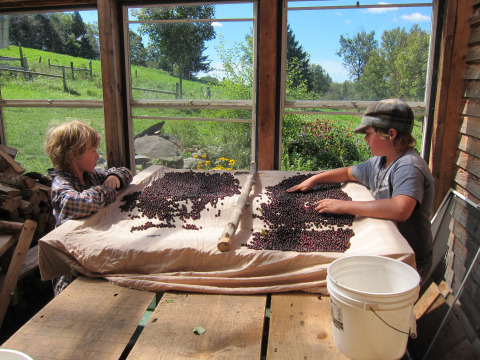Putting it By
Spreading choke cherries to dry
Troutmama left a comment yesterday about how we preserve our green beans, which made me wonder if perhaps a preservation post was in order. Food preservation is a huge part of our life. It’s not our favorite part, not by a long shot (though there are elements of it – like butter making – that I find particularly satisfying), but it’s absolutely essential to our personal homestead economy. If we didn’t preserve the quantity and diversity of food we do, we couldn’t pull all this off. And by “all this,” I mean everything, because without our food stores to rely on over the winter, there’s just no way we could afford to live the way we do. I can’t even begin to imagine how many thousands of dollars worth of food we preserve every year, but I bet it’s the difference between me doing what I do for a living and actually having to work. Ugh. Gives me chills just writing it.
The age-old method of belly preservation
To answer the specific question at hand, we preserve green beans two ways: Freezing and fermenting. We ferment far more than we freeze; maybe 25 quarts fermented compared to 10 or so frozen. Fermenting green beans is particularly easy; all we do is give them a quick rinse, stick them into quart and half-gallon jars (we don’t even cut the stems off) and cover with salt-water brine (2 tablespoons salt per quart). If we’re feeling particularly ambitious, we’ll add some dill and/or garlic.
Anyhow. Our primary preservation methods are as follows:
Fermenting
Freezing
Drying
Cold storage (aka “root cellaring”)
Of course, each has its strengths and weaknesses. Fermenting for instance is freakin’ fantastic and phenomenally fun! It’s also low energy input, incredibly reliable, and probably as healthy as it gets. It’s sort of like the stone axe of food preservation. But there’s also a particular taste and odor associated with fermented vegetables that’s not entirely impossible to grow weary of by, say, the end of January. Primary foods we ferment: Kimchi/sauerkraut, grated carrots with ginger, green beans, salsa, cukes (aka “pickles”), dairy (mostly in the form of kefir). Foods we have fermented that we will never ferment again: Broccoli, fiddlehead ferns, zucchini, peas, blueberries and probably a few others I’ve thankfully forgotten.
Preserving “on-the-hoof.” These girls are now ready for slaughter
Freezing is convenient as all get out, and the results are super predictable. Downsides? Well, it’s energy intensive (though given the quantity of food you can fit into a chest freezer, not really all that bad), and dependent on mechanization. We have, count ‘em, five chest freezers. Foods we freeze: Meats (beef, pork and all associated by products with the exception of some dry-cured sausage, chicken, lamb, wild game), butter, some veggies (green beans, corn, peas, broccoli, kale), blueberries, wild blackberries, strawberries, bone broths, and leftover soups and stews. There’s other stuff, of course, but this is the bulk of it.
We’re dying to be trying to do more drying, but have yet to settle on a satisfactory solar dryer design. We dry some in the oven at low temp, and also in the porch with its clear roof panels. We also built a rack over the cookstove. Foods we dry regularly: Herbs and spices, veggies (tomatoes, zucchini, celery leaves, red and green peppers, kale, etc), wild mushrooms, woods nettles, apples, blueberries, melons, beef jerky, sausage, and a whole bunch of stuff I’m not thinking of at the moment. Drying is fairly convenient, extremely reliable, and does a great job of preserving nutrients. We just gotta figure out our system a bit better.
Cold storage. This is a huge component of our preserving, particularly in relation to staple root crops. In our root cellar we have: Potatoes, beets, carrots, and all our fermented foods (once these go through an initial room-temperature ferment, they go to the root cellar). We also have onions and garlic stored in the basement, where it’s not quite so cold and also a bit less humid. And we have a “squash room” that’s even a bit warmer for winter squash. We eat a good bit of winter squash, particularly delicata, acorn, and sunshine.
Firewood and ferments. Two of our most-critical wintertime stashes
I think I’ve mentioned this before, but we don’t can much of anything (applesauce is the one major exception. Oh, and maple syrup, I suppose). We really, really dislike canning – hot, energy intensive, and not particularly nutritive.
We also make our share of medicinal tinctures and whatnot, including (this one’s for you, Matron!) the nine quarts of elderberry syrup Penny just whipped up. This was not planned, but a friend brought us a huge stash of elderberries she’d frozen and wasn’t going to get to, and so… bottoms up!
Alrighty, that’s about enough for now. I don’t think our food preservation methods are perfect; for instance, we’d dearly love to refine our drying technique to make it easier to dry large quantities without electricity or propane. We’ll get there. And we’d love to figure out how to reduce our dependence on our freezers. But the truth is, sometimes you just gotta do what you gotta do, particularly in the heat of the harvest, when the quantity of fresh food coming into our house often feels overwhelming.
Monday lunch and dinner: Lamb and venison soup, with carrots, potatoes, chanterelle mushrooms, red peppers, zucchini, beef broth, thyme, salt, pepper

Ben Hewitt's Blog
- Ben Hewitt's profile
- 37 followers






